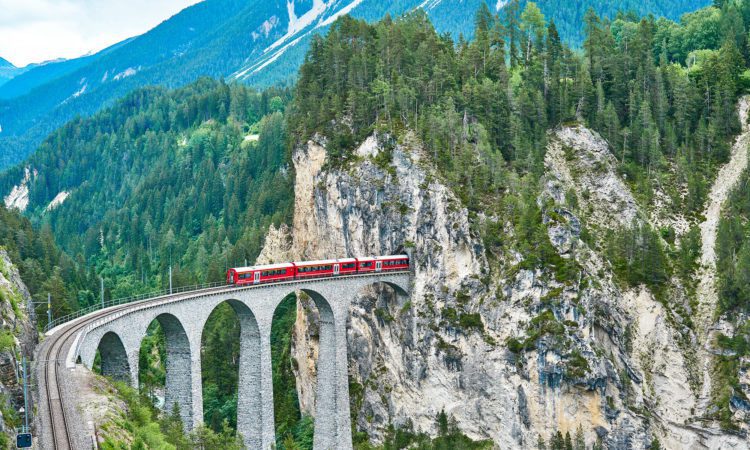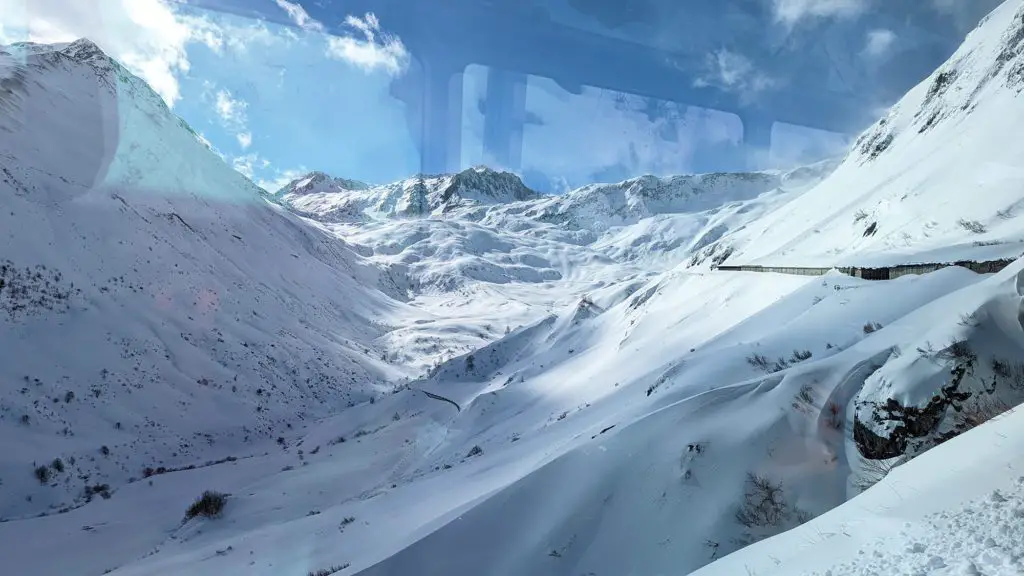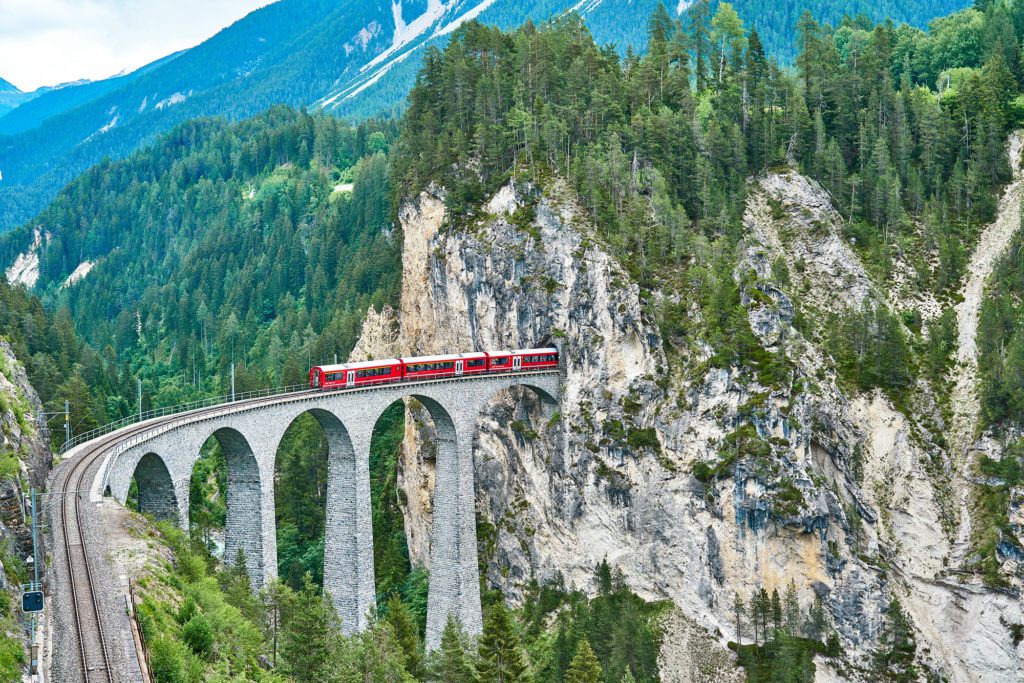
The Glacier Express is one of the most scenic train rides in the world, but can be made even better by visiting Switzerland during the best time of the year. You’ll have your choice of weather and scenery depending on what month you pick.
Contents
What to expect on the Glacier Express in winter
December, January and February will great you with vast snowy vistas throughout your entire 8 hour ride on the Glacier Express. This is an unbelievable sight that most will not get to see during their vacation. Mountains can be seen on trains all over the world, but it is rare to be able to travel over a snow filled pass with beautiful mountains in the background.
February is the best time to ride the Glacier Express, due to it’s unique scenery and guarantee of a snow filled landscape. The price of seat reservations will also be CHF 10 cheaper in the winter than the summer. Crowds will be less and you’ll have an easier time making last minute changes and seat reservations.
For info on what exact time you’ll see all the sights, check out our Glacier Express route guide with time stamps of the best views.
One great feature of the Glacier Express is that it is timed so you don’t miss any of the views due to sunrise or sunset, no matter the season. Even in February, the train left Zermatt at 8:52am, after sunrise, and arrived in St. Moritz before 5:00pm. We were initially afraid we might miss views on the front or back end due to the sun, but that was not the case.

The section of the Glacier Express from Andermatt to Disentis is the most beautiful part of the route. When going through the Oberlap Pass, have your camera ready! It is more snow than we have ever seen.
If it is your first time, we’ve listed 12 things you need to know before riding the Glacier Express.

Riding the Glacier Express in December
In the Alps, expect cold temperatures in December with highs around 23 degrees F and lows of 12 degrees F. You’ll be able to see snow, but the daylight hours will be shorter than any other month. Snow will fall at an average of 10 inches per week.
Riding the Glacier Express in January
In January temperatures drop even further to an average of 21 degrees F for the high and 11 degrees F for the low. The snow picks up to 17 inches per week, setting the stage for a spectacular February.
Riding the Glacier Express in February
In February, temperatures rise, and the snow is high, with an average snowfall of 10 more inches per week. While temps do rise, they are only gradual to 24 degrees F. At this point in the year, there is plenty of snow on the ground for a beautiful trip.
The advantage of visiting Switzerland in February
You are likely not going all the way to Switzerland just for the Glacier Express, and being able to rearrange your schedule at the last minute is a big blessing to your trip planning. Since we were there in February, we were able to get VIP tickets on the Golden Pass Panorama the day of our trip. The Belle Epoch was also empty when we rode it.
When trying to reach Jungfraujoch or Gornergrat, you’ll likely want to give yourself a few shots at it, and due to weather they can be a total washout. We were able to not buy tickets in advance and just walk up to these trains due to being there in February. In the spring or summer you need to book well in advance and you are stuck with the weather you get.
Our Jungfraubahn train to Jungfraujoch in February was completely empty on a very clear day.

On the Golden Pass Panoramic VIP car, where your seats are in front of the engineer and looking forward, we had the entire place to ourselves. You cannot get seats like this as easily in the spring or summer.

What to expect on the Glacier Express in spring
Spring brings more crowds and beautiful views to the Glacier Express. As the snow begins to melt the landscape will change from white to green. Be sure not to get caught in the middle season, where the landscape is still dark and there isn’t much snow. If we needed to pick a month to visit in the spring it would be late April or early May.
Riding the Glacier Express in March
In March, which is another beautiful month to ride the Glacier Express, snowfall starts to fall off to 8 inches per week and the temps rise by about 5 degrees F. March is almost as good as February for riding the Glacier Express.
Riding the Glacier Express in April
April temperatures will rise to a high of 36 degrees F and lows in the mid 20’s. Snow tapers off even further, but you still should have great snowy landscapes to view out the big picture windows on the Glacier Express.
Riding the Glacier Express in May
May is a turning point for the Glacier Express season. Snowfall will drop to just a few inches per week and the high temperatures will now reach the mid 40’s in the Alps. You’ll still have a varied weather pattern in the other parts of the region where the Glacier Express runs, but there will be much less snow and even higher temperatures.
What to expect on the Glacier Express in summer
Summer is the high season for the Glacier Express and brings the most crowds, but the weather is spectacular. You’ll see much less snow, and it won’t feel as much like the Swiss Alps as it would during other parts of the year. For most of the route, the snow will be gone. The views will still be magnificent though.
Costs of hotels will rise and you’ll generally have much less of a chance to be flexible in the summer months.

Riding the Glacier Express in June
Snowfall in the Alps will start to cease in June, with just a scattered shower here or there. Daytime highs will reach the mid 50’s F at higher elevations. Snow will be gone in many regions of the trip.
Riding the Glacier Express in July
July is the warmest month in the Alps and on the Glacier Express, with high temperatures of almost 60 degrees F. The snow will largely be gone from the route with possible glimpses of it here and there. The Glacier Express will get the most hours of sun during July.
Riding the Glacier Express in August
August on the Glacier Express is almost the same as riding in July. The snow will be gone and temperatures remain high. The crowds will be heavy and prices are also expensive for hotels in the summer.
What to expect on the Glacier Express in fall
The fall is the worst time to try to ride the Glacier Express. It is low season, and before it snows, the landscape can start to look very dark. You will see some nice color in the trees on some parts of the route, but if you time it poorly and that color has passed it’ll just be a poor view.
Riding the Glacier Express in September
As the Glacier Express tries to get one more good month from the landscape, the crowds will start to dwindle on the trains. The temperature remains fairly high at 50 degrees F, but a lack of snow diminishes the views. Riding the Glacier express in September is not recommended.
Riding the Glacier Express in October
Service comes to a close on the Glacier Express in mid October, and this is not a good month to ride the train. The snow will be minimal on the ground and the views are not as pretty as most any other month. Riding the Glacier Express in October is not recommended.
Riding the Glacier Express in November
The Glacier Express does not run in November. If you would like to travel the same route as the Glacier Express during this time period, you can use normal or regional trains to accomplish the same thing, but without the features of the Glacier Express.
What should you bring with you on the Glacier Express
Sunglasses. If you are taking our suggestion and are going to travel during months where there is snow on the ground you’ll want to bring sunglasses with you on the Glacier Express. The sun reflecting off the white snow is incredibly bright and can overpower some passengers if they don’t have sunglasses with them.
The temperature of the train cars are climate controlled so you won’t likely need to worry about an extra jacket or hat while you ride.
When you add up all the factors that go into making a great and memorable trip to Switzerland, February is the best time to go ride the Glacier Express.







